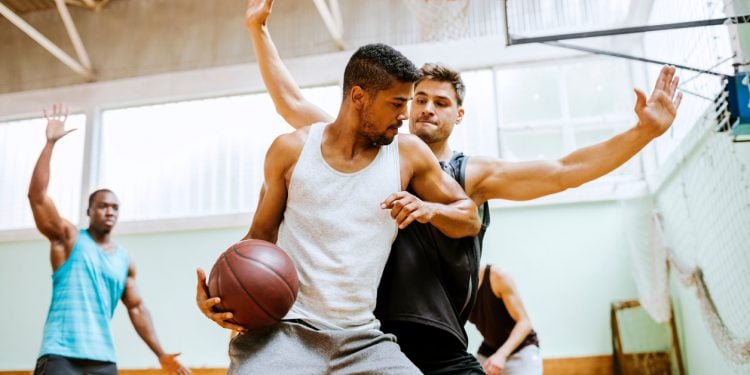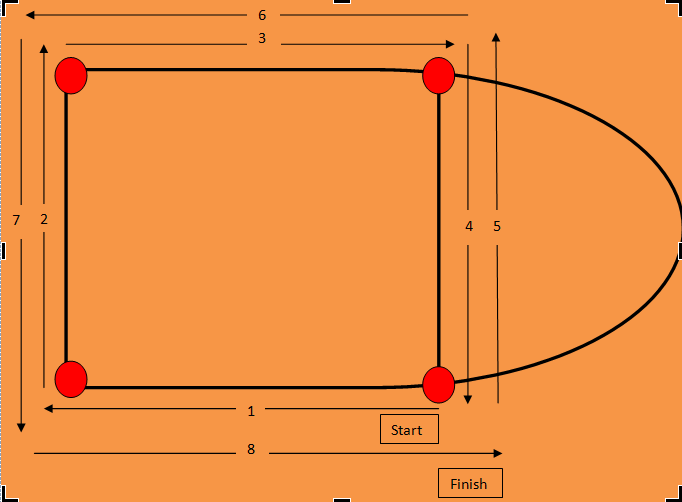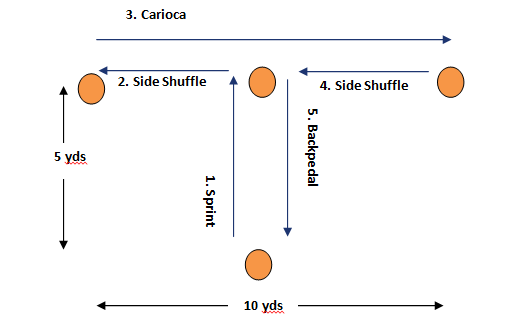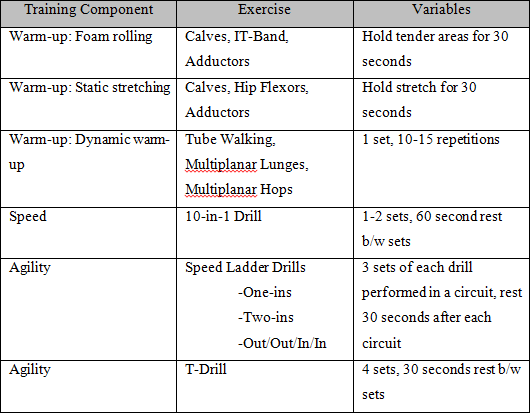Speed and agility training is crucial for basketball players to improve footwork skills as well as improve cardio-respiratory stamina. Speed and agility training is also key in decreasing injury for basketball players.
This article will review the rationale for speed and agility training for the sport of basketball and provide drills to enhance performance and decrease the risk of injury.
More information can be found in NASM's Sports Performance Certification (NASM-PES)
the movements required for basketball
Basketball is an extremely dynamic sport that requires movements in multiple planes of motion as well as rapid transitions from jogging to sprinting to jumping. The ability to quickly elude defenders, rapidly decelerate to take a jump shot, or explosively jump up to grab a rebound are all skills required to effectively play the sport.
It is equally important for the athlete to be able to perform these skills in a variety of directions and in a controlled manner to ensure injuries do not ensue. Due to the myriad of physical demands that come with the sport makes speed and agility training a crucial component to incorporate into a basketball training program.
Rationale for Speed and Agility Training for Basketball
Research has demonstrated that speed and agility training follows the principle of specificity, showing that straight (linear) speed training produces improvements in straight ahead speed with little carry-over to agility and vice versa (1). Thus, it is important to train these elements as separate components to ensure both speed and agility are being developed maximally.
It has been shown that eight weeks of sprint training can improve performance in the maximum speed phase of sprinting (20-40 meters) and resisted sprint training (pulling a sled weighted with a 5-kilogram load) can improve the acceleration phase of sprinting (10 meters) (2). Research has further demonstrated that agility training can improve one’s ability to change direction (agility) (1).
Research has also shown that running and cutting maneuvers associated with many land-based sports can produce high levels of altered forces involved in non-contact injuries such as an ACL injury (3-5). Several authors have found that the use of specific exercise programs incorporating various forms of speed and agility drills can significantly reduce the incidence of injury, especially to the lower extremities, while improving performance (6-13).
Many of these studies have made it a point to focus on the mechanics/technique and a systematic progression of the exercises used and not just the exercises themselves. This is necessary to help ensure that the body is being re-trained to move in biomechanically correct positions in a progressive manner and ultimately reducing excessive stress to the joints and connective tissues.
Speed and Agility Drills for Basketball
Speed can be defined as the amount of velocity a person has in any given direction (14). Typically, this refers to how fast someone can run in a forward directed, straight path of motion. Therefore, speed is the straight-ahead velocity of a person or how fast a person can run forward (also known as sprinting).
With this said, speed drills would include those in which the athlete is required to run in a linear path. Example speed drills that would be appropriate for a basketball player would include:
- 10-in-1 Drill (sprint from one baseline to the opposite baseline and back to the original baseline, repeating five times for a total of 10 lengths of the court)
- 30-yard sprint: acceleration and maximal speed
- ¾-court sprint (sprint from the baseline at one end of the court to the free throw line on the opposite end of the court)
These drills will help improve straight ahead speed and deceleration capabilities required during transition periods and fast breaks that are performed in basketball. The drills can also be performed on the court and do not require a field.
Refer to NASM’s Performance Enhancement Specialization course for more basketball speed drills.
Why is Agility important for sports performance?
Agility is the ability to start (accelerate), stop (decelerate and stabilize), and quickly change direction while maintaining proper postural alignment (15).This requires high levels of neuromuscular efficiency (movement coordination) because the athlete is constantly regaining their center of gravity over their base of support while changing directions at various speeds.
All of these elements are very common in basketball and will be important to train for. Example agility drills that would be appropriate for basketball include:
- Pro-lane Agility Drill (sprint around cones following the below pattern)
- Agility Ladder Drills
- T-drill (sprint around cones following the patterns)
These drills are designed to help improve deceleration capabilities, change in direction and foot work skills required for basketball. Like the speed drills, these agility drills can also be performed on the court. Care should be taken when performing agility ladder drills on a basketball court to ensure the athlete does not slip on the ladder due to the slick floor surface.
Refer to NASM’s Performance Enhancement Specialization course - as well as our smaller Speed, Agility and Quickness course, for these and more agility drills for basketball.
Below is an example speed and agility program that can be used for basketball. This program can be performed on non-OPT training days. For example, OPT training (core, balance, plyometrics and integrated resistance training) can be done on Monday, Wednesday, and Friday while speed and agility training can be done on Tuesday and Thursday.
Check out Plyometrics: Developing Power in Everyday Athletes for more great information.
Summary
The sport of basketball requires many changes in direction, quick movements and explosive jumping. To ensure the athlete can perform these skills properly and handle the stresses that come with the sport, speed and agility training will be an important training component to include in the training regimen.
These drills can be incorporated into any basketball program for athletes across all levels to help maximize performance and decrease the risk of injury.
If you are interested in learning more about training athletes, you want an introduction to Speed, Agility, and Quickness training, or want to know what it takes to do strength and conditioning coaching for basketball, get in touch with us today!
Be sure to subscibe to our youtube channel for more related content!
And check these blogs out if you want to learn more about basketball through an NASM lens:
References
- Young WB, McDowell MH, Scarlett BJ. Specificity of sprint and agility training methods. J Strength Cond Res 2001;15(3):315-9.
- Zafeiridis A, Saraslanidis P, Manou V, Ioakimidis P, Dipla K, Kellis S. The effects of resisted sled-pulling sprint training on acceleration and maximum speed performance. J Sports Med Phys Fitness 2005;45(3):284-90.
- Besier TF, Lloyd DG, Cochrane JL, Ackland TR. External loading of the knee joint during running and cutting maneuvers. Med Sci Sports Exerc 2001;33(7):1168-75.
- Besier TF, Lloyd DG, Ackland TR, Cochrane JL. Anticipatory effects on knee joint loading during running and cutting maneuvers. Med Sci Sports Exerc 2001;33(7):1176-81.
- Besier TF, Lloyd DG, Ackland TR. Muscle activation strategies at the knee during running and cutting maneuvers. Med Sci Sports Exerc 2003;35(1):119-27.
- Padua DA, Marchall SW. Evidence supporting ACL-injury-prevention exercise programs: a review of literature. Athl Ther Today 2006;11(2):11-23.
- Hewett TE, Zazulak BT, Myer GD, Ford KR. A review of electromyographic activation levels, timing differences, and increased anterior cruciate ligament injury incidence in female athletes. Br J Sports Med 2005;39(6):347-50.
- Mandelbaum BR, Silvers HJ, Watanabe DS, Knarr JF, Thomas SD, Griffin LY, Kirkendall DT, Garrett W Jr. Effectiveness of a neuromuscular and proprioceptive training program in preventing anterior cruciate ligament injuries in female athletes: 2-year follow-up. Am J Sports Med 2005;33(7):1003-10.
- Olsen OE, Myklebust G, Engebretsen L, Holme I, Bahr R. Exercises to prevent lower limb injuries in youth sports: cluster randomised controlled trial. BMJ 2005;330(7489):449.
- Myer GD, Ford KR, Palumbo JP, Hewett TE. Neuromuscular training improves performance and lower-extremity biomechanics in female athletes. J Strength Cond Res 2005;19(1):51-60.
- Myer GD, Ford KR, Hewett TE. Rationale and Clinical Techniques for Anterior Cruciate Ligament Injury Prevention Among Female Athletes. J Athl Train 2004;39(4):352-364.
- Paterno MV, Myer GD, Ford KR, Hewett TE. Neuromuscular training improves single-limb stability in young female athletes. J Orthop Sports Phys Ther 2004;34(6):305-16.
- Stasinopoulos D. Comparison of three preventive methods in order to reduce the incidence of ankle inversion sprains among female volleyball players. Br J Sports Med 2004;38(2):182-5.
- Enoka RM. Neuromechanics of human movement. 3rd ed. Champaign, IL: Human Kinetics; 2002.
- Parsons LS, Jones MT. Development of speed, quickness and agility for tennis athletes. Strength Cond J 1998;20:14-





















